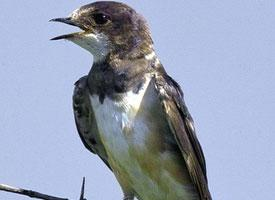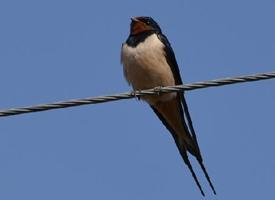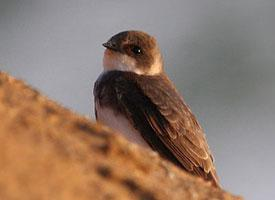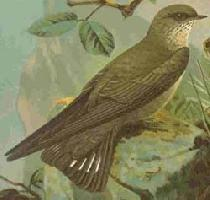
Popis zvířete
The Banded Martin (Riparia cincta) is a captivating bird species belonging to the swallow family, Hirundinidae. It is characterized by its distinctive appearance and fascinating behavior, making it a subject of interest for birdwatchers and ornithologists alike. This species is predominantly found in sub-Saharan Africa, where it inhabits open landscapes such as savannas, grasslands, and lightly wooded areas, often near water bodies like rivers, lakes, and wetlands.Adult Banded Martins are small to medium-sized birds, measuring about 12-13 cm in length. They possess a relatively robust body, a short neck, and a small head, with a short, narrow bill adapted for catching insects in flight. Their wings are long and pointed, indicative of their aerial lifestyle, while their tails are slightly forked, aiding in agile flight maneuvers.
The plumage of the Banded Martin is notably attractive and serves as the basis for its common name. The upper parts of the bird are predominantly brownish-gray, while the underparts are white. A distinctive feature of this species is the broad, dark band that runs across the chest, contrasting sharply with the white throat and belly. This banded pattern is present in both males and females, making them relatively easy to identify in the field.
One of the most interesting aspects of the Banded Martin's life is its breeding behavior. The species is known to nest in colonies, with pairs excavating horizontal tunnels in sandy banks or earth cliffs near water. These tunnels, which can be quite long, end in a chamber where the female lays her eggs on a bare surface or on a simple bed of plant material. Both parents are involved in incubating the eggs and feeding the hatchlings, showcasing a remarkable level of parental care.
Banded Martins are highly social birds, often seen flying in flocks while foraging for food. Their diet primarily consists of flying insects, which they catch with remarkable agility in mid-air. This aerial feeding strategy allows them to take advantage of the abundant insect populations in their habitats, especially during the rainy season.
Migration is another key aspect of the Banded Martin's life cycle. While some populations are resident, others undertake seasonal migrations to exploit different feeding and breeding opportunities. These migrations are influenced by weather patterns and food availability, underscoring the species' adaptability to its environment.
In summary, the Banded Martin (Riparia cincta) is a fascinating bird with a distinctive appearance and intriguing behaviors. Its presence enriches the biodiversity of the African landscapes it inhabits, contributing to the ecological balance by controlling insect populations. Despite facing threats from habitat destruction and climate change, the Banded Martin continues to thrive in suitable environments across sub-Saharan Africa, captivating the hearts of those who have the chance to observe it in the wild.
Podobná zvířata
Nové fotografie zvířat
Top 10 zvířat
- Chinese water dragon (Physignathus cocincinus)
- Galápagos tortoise (Geochelone nigra complex)
- Dolphin gull (Leucophaeus scoresbii)
- Japanese macaque (Macaca fuscata)
- Colombian red howler (Alouatta seniculus)
- Sea urchins (Echinoidea)
- Diana monkey (Cercopithecus diana)
- Moustached guenon (Cercopithecus cephus)
- Common house mosquito (Culex pipiens)
- Colossal squid (Mesonychoteuthis hamiltoni)


